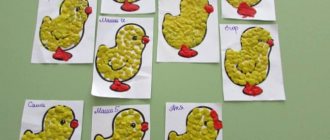Conversation. Conducting conversations - Educational conversation “If you want to be healthy” for children 6–6.5 years old
Publication “Educational conversation “If you want to be healthy” for children 6-6.5...” Age - for children 6-6.5 years old Educational areas: “Cognition”, “Physical development”, “Speech development”. Goal: To develop children’s initial ideas about a healthy lifestyle. Objectives: Educational: Expand children’s understanding of the structure of the human body, the meaning...
General conversation for children of the middle group “How forest animals spend the winter in the forest” Objectives: to promote the formation of generalized ideas that different animals live in the forest, that winter is a difficult time of year for everyone, that animals are differently adapted to life at this time year; to form an idea of the role of man in the life of animals in the forest in winter...
Conversation in the middle group “Vegetables and fruits are healthy foods”
Goal: Systematize and expand knowledge about vegetables and fruits, their diversity; introduce children to vitamins and reveal their importance for human health; Progress of the lesson: The teacher greets the children and says: “Now the one who repeats after me will sit down. Tomato, beet,...
Thematic conversations with preschoolers in the middle group December Topic of the week No. Conversation Goal 1 week “Culture” 1 “Child and the book” Cultivate a love for books, a desire to meet them again. Sympathize and empathize with the characters of the work. Experience the pleasure of encountering poetry. 2 “Fine arts” Educate…
Middle group. Junior preschool age. Children 4 - 5 years old
Summary of an ecology lesson “Conversation about insects” in the middle group Objectives: - to consolidate children’s ideas about insects, to teach them to identify their main features (articulated body structure, six legs, wings, antennae, to develop knowledge about how insects protect themselves from enemies. - develop the ability to compare, identify common and distinctive features...
Conversation with children in the middle group “I will save my health, I will help myself!” Conversation with children in the middle group. Topic: “I will save my health, I will help myself!”
Conducted in MADOU D/S9 group No. 3 "Goal: formation of the concept of "health"
. Objectives: to give an idea of the rules of a healthy lifestyle, to reveal positive and negative factors affecting health...
Summary of an individual conversation on the development of dialogical speech in a child in a preparatory group
Summary of an individual conversation in a preparatory group for school with the aim of developing dialogical speech in a child.
Skills developed in this conversation: 1. Develop the ability to maintain a conversation; 2. Continue to improve dialogic speech; 3. To develop the ability to conduct dialogue between the teacher and the child, between children; teach to be friendly and correct interlocutors, cultivate a culture of verbal communication; 4. Help create a story plan and stick to it. Develop the ability to write stories from personal experience. Please guess the riddle : Twelve brothers follow each other, but do not overtake each other... (Months). Questions for conversation:
– That’s right, these are months.
What time of year is it now? – Please remember and tell me the autumn months? - Right! Tell us what changes in nature occur in autumn? – What are the names of birds that fly to warmer climes? – What are the names of the birds that stay with us for the winter? – Name what migratory and wintering birds you know. – Why do you think birds fly south? – Is it possible to somehow help the birds left to spend the winter in the city? – Do you know why the leaves turn yellow and fall off in the fall? – The leaves contain a substance - chlorophyll, which makes them green, but due to a lack of sun, this substance ceases to act, and instead of this, other substances appear that color the leaves yellow, orange and crimson. Fewer and fewer nutrients are supplied through the leaves, and the tree no longer needs them. The petioles of the leaves hold onto the tree less well, gradually flying off it from the slightest gust of wind. Fallen leaves bring considerable benefits to trees: they form a wonderful layer of fertilizer that nourishes the tree. – What can happen to a tree if the leaves don’t fall? – You also said that vegetables and fruits are collected in the fall. How can you call it in one word? – What vegetables and fruits can be collected from our gardens, fields and orchards? – What do people do with vegetables and fruits for the winter if they have had a rich harvest? – Do you and your parents prepare for the winter? Which? – What happens to wild animals and insects in the fall? – What animals can you name that hibernate? – How does the life of animals that do not hibernate change? – I think that you and I remembered a lot about autumn and now we can play a little. Game “Yes-no” The purpose of the game:
the development of logical thinking and broadening the child’s horizons.
The teacher offers statements. If the statement is correct, the child says: “Yes!” and claps his hands. If the statement is not true, then the child says: “No!” and stomps his feet. Example statements:
It is raining today.
It's autumn outside. Ground is covered with snow. September is a winter month. October is an autumn month. September, October, November are the autumn months. There is snow in autumn. In autumn, birds fly south. In autumn there are a lot of mushrooms and berries in the forest. Result: - What did we talk about? — What changes occur in nature in autumn? - Name 3 months of autumn.
We recommend watching:
Conversation with children of the preparatory group on the topic “Blossoming of the meadow” Summary of the conversation in the preparatory group on the topic “Signs and sayings about autumn” Creative meeting of Maya Nikolaevna Shilova with kindergarten students Ecological conversation about forest dangers for older preschoolers (5-7 years old)
Similar articles:
Conversation on the topic “Fruits” in the senior preparatory group
Summary of the conversation in the senior group “Good will not die, but evil will disappear”
Conversation about generosity and greed with children of the senior preparatory group
Conversation for children “A lie does not make a person beautiful.” Senior group
Conversation about the Constitution for older preschoolers
Development of material on the topic of individual conversation
Summary of an individual conversation with parents.
1. Object of conversation:
student's parents.
2. Topic of conversation:
“How to overcome a child’s shyness and insecurity”
3. Purpose of the conversation
: to form parents’ ideas about the impact of a child’s shyness and uncertainty on educational success.
4. Objectives of the conversation:
a) establish psychological contact with parents;
b) discuss with parents the problem of the influence of shyness and uncertainty on the student’s educational success;
c) contribute to the formation in parents of a desire to help their own child overcome shyness and uncertainty;
d) discuss with parents ways to overcome the child’s shyness and uncertainty at home and at school.
5. Conversation plan:
1) Greeting;
2) Main part;
a) The theoretical aspect of the emergence of shyness and uncertainty;
b) Questions asked to parents;
c) Questions that parents have;
d) Memo for parents on overcoming shyness and self-doubt in their children.
3) Conclusion.
Contents of the conversation
(supporting concepts, questions, conversation structure).
Greetings:
Hello! I would like to have a consultative conversation with you on the topic “How to overcome a child’s shyness and insecurity.”
Main part:
Even in the most extreme and neglected
forms of shyness and uncertainty will pass,
if you put in the work of your soul to overcome them.
V. Levi
Almost every person experiences a feeling of fear in their life. Some people are afraid of heights, others are afraid of snakes. But this can be avoided in life. What about those who are afraid of people? First of all, this applies to shy people and insecure children. They feel insecure with their peers during recess and even more so in class. Such children may know all the educational material of the lesson, but are afraid to raise their hand, answer in front of the class, afraid to make a mistake.
Often teachers who work with such students get the impression that they have low intellectual potential, a narrow outlook, and undeveloped learning skills. A child who subtly senses the teacher’s attitude toward himself becomes withdrawn, closed, stops communicating with peers, and tries to run home from school as quickly as possible. Gradually, this state of affairs forms his low status in the team.
A bleak picture, isn't it?
(Parents' answers)
And if he does not receive support and attention at home, the situation can turn into a tragedy.
(Parents' questions)
Shyness is a flexible concept; The more closely we look, the more varieties we see. Therefore, even before we begin to figure out what to do with it, it doesn’t hurt to learn more about it.
The Oxford English Dictionary reports that the first written use of the word "shy" was after the birth of Christ and meant "easily frightened." “To be shy” means to be “difficult to approach because of timidity, caution, or mistrust.” A shy person is “apprehensive and disinclined to meet or have contact with any particular person or thing.” “Impressive, timid, reluctant to assert his rights,” a shy person may be “prone to solitude or secretive due to lack of self-confidence” or due to fear of harassment, his antipode, “doubtful, suspicious, “dark” personality.”
Webster's Dictionary defines shyness as “awkwardness in the presence of other people.”
(Parents' questions)
Shyness occurs when a child concentrates on what others, especially strangers, think about him. He is afraid that he will not meet other people's expectations and will be rejected. Tension affects his physiological state. He blushes, speaks haltingly and quickly, and becomes clumsy.
4 reasons for shyness:
1. Children are more sensitive and impressionable to this behavior and react sharply to any changes and conflicts. Therefore, any careless word or unpleasant situation can make them withdraw into themselves. Often such children grow up in families where parents try to constantly control their behavior.
2. Deprived of freedom, the child loses self-confidence and independence.
3. Endless criticism is also the reason for the formation of shyness. When children are criticized too often, they stop doing anything to avoid making mistakes and being pressured. It is more difficult if critical parents also compare the child with a more successful brother or friend.
4. And finally, children can simply copy the behavior of their parents. If there is a shy father or mother in the family, then the child simply will not have an exemplary example symbolizing self-confidence.
Memo for parents.
Here are some rules to follow when interacting with your shy child.
1. Praise your child for achievements that were achieved through hard work and perseverance.
2. Condemn not the child, but his unworthy actions.
3. Set feasible goals for your child and evaluate their achievement.
4. Do not ignore any child’s efforts to overcome self-doubt.
5. Have a heart-to-heart talk with your child, give them the opportunity to speak out and share their painful issues.
6. Do not prevent your child from making mistakes, do not replace his life experience with yours.
7. Do not instill in your child fear and apprehension towards yourself.
8. Ask your child if he doesn’t tell you anything, do it tactfully and warmly.
9. Rejoice in his victories over himself.
10. Be there for him if he needs it!
6. Literature used when preparing the conversation:
1. Zimbardo, F. Shyness / F. Zimbardo. – M.: Pedagogy, 2005. – 284 p.
2. Vachkov, I.V. Group methods in the work of a school psychologist / I.V. Vachkov. – M.: Os, 2009. – 179 p.





